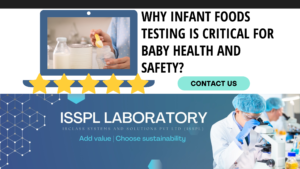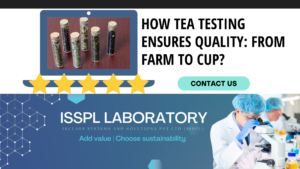An Overview by Team ISSPL - Analytical Testing Laboratory in India
ToggleIn the last few years, one can identify various instances of melamine contamination in food and edible products. Melamine is a chemical essential for the production of resin and plastic materials. The long-term consumption of melamine is not appropriate for the body. It is toxic. One can find the ultimate solution by connecting with the contaminant testing laboratory and reviewing the presence of the toxin in the food. The various testing methods can help detect melamine and cyanuric acid in the feed products.
The toxic impact of melamine
Consuming melamine is harmful in more ways than one. It can impact the reproductive system, and create various side effects. One must focus on the detection of melamine in feed products. Melamine contamination in food products needs a careful testing approach where you must review the protein content. Why? Because it is an integral quality indicator. The protein analysis checks the amount of nitrogen in the feed content. Melamine percentage is higher in nitrogen and thus checking the protein contents is a convenient choice.
Melamine testing for feed products – How did it become essential?
In the last two decades, the essentiality of melamine testing in food products has increased to the next level. The contamination chances and instances have grown as well. Hence, one must focus more on the detection process. The various reports on the high levels of melamine in food and feed have triggered large-scale melamine testing across the world.
The adulteration of the food involves melamine addition. The detection steps are integral for promoting the industry, and it is specifically essential for dairy products. The large-scale adulteration of edible products with melamine powder needs a strict check. It reflects an increase in the protein content of the edible product, and the reports become misleading.
The high nitrogen content of melamine molecules misleads the testers. One may think of the edible product as a protein-rich feed product but the melamine content is not ideal for human consumption. Children can become sick after consuming baby feed like milk and dry food adulterated with melamine.
The growing concern – Know it rightly
Melamine is a popular raw material in the food and beverage industry. It is integral for producing melamine resin. The chemical is also present in plastic materials. A long-time intake of melamine can create toxic impacts on the different human body organs. The reproductive and nephron damage created by melamine is significant to note. The long-term exposure of melamine to the human body can create bladder or kidney stones, leading to bladder cancer in the long run.
In recent times, melamine has become a prime contaminating agent to the different types of human foods. The impact is more visible with dairy products like – milk powder, milk, and yogurt. The toxic impact of melamine on infants can promote urinary tract complications and acute kidney failure in a short span. One can witness infant deaths due to melamine exposure. The presence of melamine in raw milk can exhibit an enhanced protein value. However, it is not appropriate for human consumption.
The analytical testing method – The ultimate choice
Melamine testing is a mandatory requisite for exporting feed materials to Western countries. The FDA has created various norms for melamine risk mitigation. Hence, sending the feed without inspection of melamine is risky and can generate a penalty.
Nowadays, melamine testing gets carried out on structurally related compounds like – cyanuric acid, ammelide, and ammeline. The testing results depend on the global infrastructure and local laboratory structure. The top laboratories can conduct melamine testing for the dairy and dairy-related industries.
Why is melamine present in the food?
The illegal and unwanted addition of melamine to feed products and food ingredient materials is inappropriate for more reasons than one. The addition of unwanted toxic chemicals helps inflate the protein content in the food. In various food products, the protein content is vital, and one needs to add small amounts of melamine. But the added amount requires a thorough check.
Unchecked addition of melamine can produce high “protein” values in the food. It is a fraudulent activity and helps increase the profit. Hence, various business owners follow the unscrupulous path and add unwanted toxic chemicals.
The products where melamine content is significantly high are milk and its derivatives. One must maintain a careful testing approach for dairy items, milk powder, baby food and formula, yogurt, sweet biscuits, sweets, chocolates, toffees, etc. It is also a vital aspect of beverages like tea and coffee products, including instant coffee. Apart from these, high-protein products like processed chicken, eggs, pet food, animal feed, fish food, etc., also need the best testing solution.
The excessive and unwanted consumption of melamine can cause kidney problems and create an irreversible health effect. The toxic effects of melamine can also trigger high blood pressure, blood infection in urine, low urine output, and kidney infection.
Best ways to check melamine presence
The vital aspects that matter significantly for melamine testing are dynamic. It depends on the testing techniques followed by the laboratory.
- The Kjeldahl method is a world-class testing mechanism and considered the ideal standard. The testing results are reliable for the universality and precision. In fact, it is the most commonly used testing method to review protein content. The Kjeldahl method focuses on nitrogen content testing, and thus, one can check the levels of melamine in the product.
- The Near-Infrared Spectrometry, or NIR method, is a swift analytical testing technique. The testing method is useful for instant and online protein analysis. The technique depends on the absorption of EM radiation at specific wavelengths (850 nm to 1050 nm). The testing detector reviews the diffusion and absorbance rate of the sample with the help of light interaction. The NIR technique is ideal for melamine testing in milk powder.
Closing note
The food and beverage industry necessitates the best testing solutions. A lot depends on the sound quality management system, information, and reliable food testing results. The test declares if food products are safe for consumption.
Hence, one cannot ignore the critical testing methods for melamine content checks in the food. IRCLASS Systems and Solutions Pvt Ltd (ISSPL) laboratory delivers the ideal solution for accurate testing techniques and helps the food and beverage industry deliver high-quality and non-toxic feed products to consumers.
Photo by Karen Laårk Boshoff:







